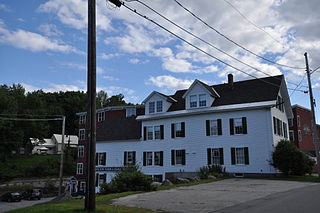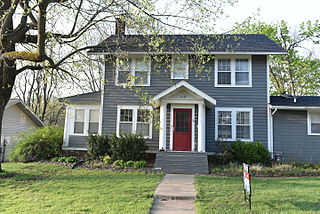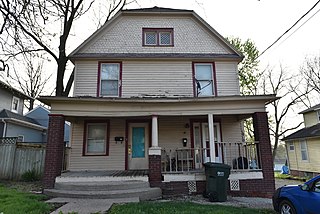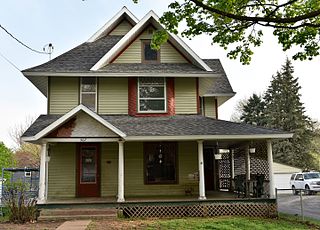
The Richard H. Mitchell House is a historic residence in Cincinnati, Ohio, United States. Built of stone throughout, this large house was designed by prominent Cincinnati architect Samuel Hannaford. Converted into a school, the house has been named a historic site.

The Edwin Bassett House is a historic house in Reading, Massachusetts. It is a well-preserved Greek Revival house, built in 1850 by Edwin Bassett, the first Reading shoemaker to install a McKay stitching machine, a device that revolutionized and led to the industrialization of what was before that a cottage industry. The house was listed on the National Register of Historic Places in 1984.

The Franklin H. Walker House was a private residence located at 2730 East Jefferson Avenue in Detroit, Michigan. It was also known as Doctor's Hospital. The house was listed on the National Register of Historic Places in 1985, but subsequently demolished. It was at the time the largest remaining house along Jefferson Avenue.

The Warren Sweetser House is a historic house at 90 Franklin Street in Stoneham, Massachusetts. It is one of the finest Greek Revival houses in Stoneham, recognized as much for its elaborate interior detailing as it is for its exterior features. Originally located at 434 Main Street, it was moved to its present location in 2003 after being threatened with demolition. The house was found to be eligible for listing on the National Register of Historic Places in 1984, but was not listed due to owner objection. In 1990 it was listed as a contributing resource to the Central Square Historic District at its old location. It was listed on its own at its new location in 2005.

The House at 113 Salem Street in Wakefield, Massachusetts is a rare well-preserved example of a 19th-century shoemaker's shop. The 1-1/2 story wood frame house was built in the 1840s or 1850s, and was originally the shoe shop of David Nichols, who lived at 103 Salem Street. Its early form, with the high-pitch, gable roof, is readily recognizable despite later alterations and additions. These types of buildings were once common in the town, where shoemaking was a home-based cottage industry.

The Jack Lamberson House, also known as the Maunu house, is a historic residence located in Oskaloosa, Iowa, United States. It is one of seven Frank Lloyd Wright-designed Usonian houses located in Iowa, and one of two that were constructed in Oskaloosa. Both were completed in 1951. The Lamberson house is unique from the other Iowa Usonians for its extensive use of 60º and 120º angles. It features a low, sweeping pitched roof that makes the house look deceptively large, yet it is the second smallest of Iowa's Usonians. It was listed on the National Register of Historic Places in 1988.

The Sumner-Carpenter House is a historic house at 333 Old Colony Road in Eastford, Connecticut. Built about 1806, it is a well-preserved local example of a rural Federal period residence, augmented by a modest collection of Colonial Revival outbuildings. It was listed on the National Register of Historic Places in 1991.

The Bass Boarding House is an historic house on Canal Street in Wilton, Maine, United States. It was built in 1860s, and adapted for use as worker housing for G.H. Bass & Co., whose former factory building stands next door. The building, one of a few that survive in Wilton that were adapted in this way, was added to the National Register of Historic Places in 1988. It now houses the Wilton Historical Society's Wilton Farm and Home Museum.

The Bridge Avenue Historic District is located in a residential neighborhood on the east side of Davenport, Iowa, United States. It has been listed on the National Register of Historic Places since 1983. The historic district stretches from River Drive along the Mississippi River up a bluff to East Ninth Street, which is near the top of the hill.

The Seeberger–Loring–Kilburn House is a historic residence located in Oskaloosa, Iowa, United States. The house was the work of David L. Evans, a master builder who completed it in 1859. It is the oldest known surviving work of his, and calls attention to his skill as a builder. Evans was a native of Wales and emigrated to the United States at the age of 14. He settled in Ohio and St. Louis before settling in Oskaloosa in 1845. The two-story, brick, Italianate structure features a hip roof and deck, bracketed cornice and simple hood molds. The second story was added in 1869 by Evans. Des Moines architect Frank E. Wetherell, who was born in Oskaloosa, designed an expansion of the house in 1916. It added the solarium on the east side, and a pergola on the west. The house was individually listed on the National Register of Historic Places in 1983. It was included as a contributing property in the Paradise Block Historic District in 1991.

The J.H. Riekenberg House is a historic residence located in Boone, Iowa, United States. Born in Schleswig, Germany, Riekenberg emigrated to the United States in 1867, and became a successful businessman and civic leader in Boone. He had Charles E. Edwins, a local architect, design this house, and local contractor J.J. Thoren built it in 1898. The 2½-story, frame Queen Anne house features an asymmetrical plan, steeply pitched roof, a wrap-around front porch, a variety of wall surface texture, an octagonal corner tower, and Palladian elements in the gable ends. The house was listed on the National Register of Historic Places in 1987.

The Spring Creek Meeting House-H Street Mission was an historic building in Oskaloosa, Iowa, United States. The frame building was built sometime after an 1878 fire destroyed the original meeting house. It was relocated from its original rural location to this site in 1895. The Spring Creek Meeting was organized in 1844 outside of town. It calls attention to the movement of the Quakers from a rural setting to a central location in town. After its relocation it became a mission of the Oskaloosa Monthly Meeting. This illustrates the evangelical nature of the Iowa Yearly Meeting after the Schism of 1877, and their willingness to proselytize in order to rectify the decline in membership on the frontier. Such a move was an anomaly among Eastern Quakers. The architecture itself shows a shift in Quaker meeting houses in Iowa from structures that were long and low to this one with its high-pitched gable roof. It was listed on the National Register of Historic Places in 1996. The building has subsequently been torn down.

The Dr. William E. and Ethel Rosenberger Berry House is a historic residence located in Oskaloosa, Iowa, United States. The Berry's were Quakers and members of the faculty of William Penn College. He taught classical languages and served as Dean, while she taught French. They were among the first to settle in the Penn College Addition. The college platted and sold these lots, which in turn helped the institution financially survive. The Berry's bought several lots, and built their house on one of them. Their Colonial Revival house was built in 1924 by P.W. Sparks, a local contractor. It is a two-story, frame, single-family dwelling that features a side-gable roof, an enclosed front porch, and a solarium. It is the Berry's association with the school in the context of the Quaker testimony in Oskaloosa that makes this house historic. The house was listed on the National Register of Historic Places in 1996.

The Thomas J. Conover House is a historic residence located in Oskaloosa, Iowa, United States. Thomas J. Conover was a farmer who retired to town as a widower about 1910. He and his daughter Casa Mae Conover, lived here together while she worked at William Penn College. Between 1925 and 1951 she was a teacher of religious education, assistant registrar, secretary to the president, and the registrar. Single women who worked for the college rarely owned their own home. This suggests the difference in pay between men and women at the institution, even as it espoused gender equality. Casa had to live with her father and care for him in his old-age. Their Colonial Revival house was built about 1910. It is a two-story, frame, single-family dwelling that features a gable-end facade roof with hip-on-gable roof embellishment, fishscale shingles on the gable end, and a full-length front porch. It is the Casa Mae Conover's association with the school in the context of the Quaker testimony in Oskaloosa that makes this house historic. It was listed on the National Register of Historic Places in 1996.

The William A. and Ida C. Johnson House is a historic residence located in Oskaloosa, Iowa, United States. The Johnsons, who were farmers, moved to town so that their children could attend Quaker schools there. This was typical of many Quaker families of that era. Other family members also boarded with them so they too could attend the schools. William Johnson also served on the William Penn College Board of Trustees, and served as its president from 1915 through 1922. It was during his tenure that the Main Building was destroyed by fire and the college moved to its present location. This Queen Anne style house is a 2½-story, frame, single-family dwelling. It features a wrap-around full-width porch with a gable-end entryway, and a bay window on the main facade. The house is capped with a complex roof of intersecting steeply-pitched gables. It is the Johnsons' association with the school in the context of the Quaker testimony in Oskaloosa that makes this house historic. It was listed on the National Register of Historic Places in 1996.

The Dr. William H. and Mae R. Klose House is a historic residence located in Oskaloosa, Iowa, United States. Dr. Klose taught German at nearby William Penn College, and was one of the longer serving faculty members. His dedication to the school helped it survive through its years of turmoil. They were also among the first to settle in the Penn College Addition. The college platted and sold these lots, which in turn helped the institution financially survive. This Colonial Revival style house is a 1½-story, frame, single-family dwelling. It features a side-gable roof, a facade gambrel dormer, and a bay window to the right to the main entry. It is the Klose's association with the school in the context of the Quaker testimony in Oskaloosa that makes this house historic. It was listed on the National Register of Historic Places in 1996.

The Prof. Edgar H. and Irene D. Stranahan House is a historic residence located in Oskaloosa, Iowa, United States. Both Stranahans taught religious education at William Penn College, and he was one of the longer serving faculty members. Their daughter Esther taught religion at the college, which calls attention to family members from more than one generation who worked at the college. Edgar also served as master of ceremonies for the Oskaloosa Chautauqua in the 1920s. The Stranahans were among the first to settle in the Penn College Addition. The college platted and sold these lots, which in turn helped the institution financially survive. This two-story, single-family, frame dwelling is covered with stucco. It features vertical boards that define pilasters on the main facade, Moorish-type arch worked into the stucco, a front entry with pilasters that support a pedimented gable roof, and a solarium. It is the Stranahans' association with the college in the context of the Quaker testimony in Oskaloosa that makes this house historic. It was listed on the National Register of Historic Places in 1996.

The Oskaloosa Monthly Meeting of Friends Parsonage is a historic building located in Oskaloosa, Iowa, United States. Its historic significance is found in its association with nearby William Penn University in the context of the Quaker testimony in Oskaloosa. The country's entry into World War I created problems for the Quaker's Peace Testimony. The Oskaloosa Monthly Meeting counseled students from the college about military conscription and pacifism. Because of this the parsonage was vandalized in 1917 with yellow crosses painted on the house. The congregation's pastor, Clarence Pickett, was tied to a spring wagon and led through town. Some vandalism also occurred during World War II, including yellow paint smeared on the parsonage.

The President's Cottage is a historic residence located in Oskaloosa, Iowa, United States. From 1892, when it was built, to 1918 this structure housed the president of William Penn College. It highlights the school's improved finances at the time of its construction, the importance it placed on its leadership, and its association with the Quaker testimony in Oskaloosa, which makes this house historic. The placement of the house on a corner lot at the end of College Avenue gave the campus a linear feel in the "Yale Row" concept of college design. Absalom Rosenberger and David M. Edwards and their families lived here during their presidencies. H. Edwin McGrew did not live in the house, and it is not certain whether some of the presidents lived here either because they already had homes in Oskaloosa. The college subsequently sold the house and it now serves as a private residence. The 2½-story frame structure features Queen Anne influences, a wrap-around front porch, and a gable-end roof with intersecting gables. It was listed on the National Register of Historic Places in 1996.

The John Lake House is a historic residence located in Maquoketa, Iowa, United States. This is one of several Victorian houses in Maquoketa that are noteworthy for their quoined corners, a rare architectural feature in Iowa. Built around 1890, the 1½-story house features limestone quoins, a gable roof, gambrel dormers on the north and east elevations, a polygonal bay under the east dormer, two small porches, and a gabled wing on the west side. A unique feature on this house are the glazed colored tiles on the main facade. John Lake was a local builder, who is associated with the construction of the New Era Building and the IOOF Building. It is possible he built this house as well, although the builder has not been determined. The house was listed on the National Register of Historic Places in 1991.























